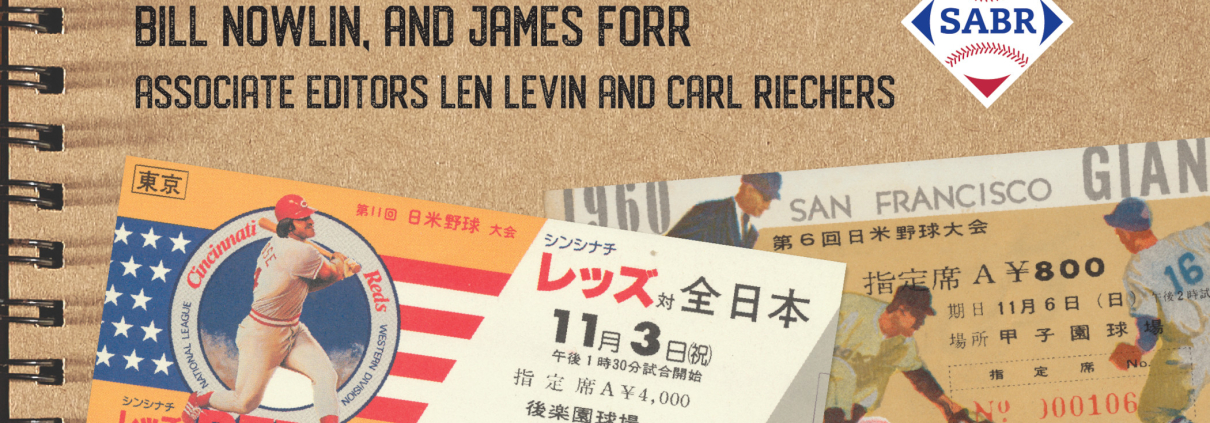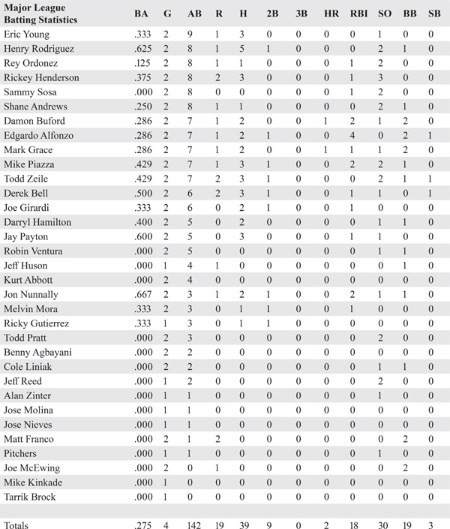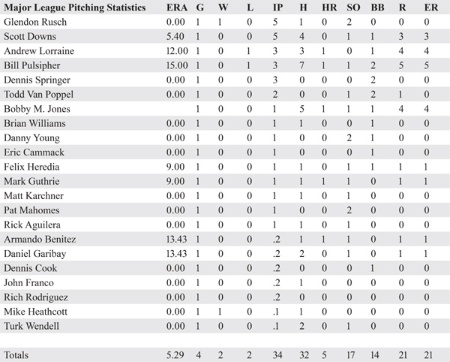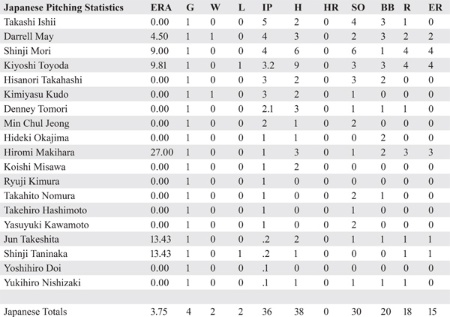Major League Baseball’s Historic Opening Day Series: New York Mets vs. Chicago Cubs, 2000
This article was written by Scott Melesky
This article was published in Nichibei Yakyu: US Tours of Japan, 1960-2019
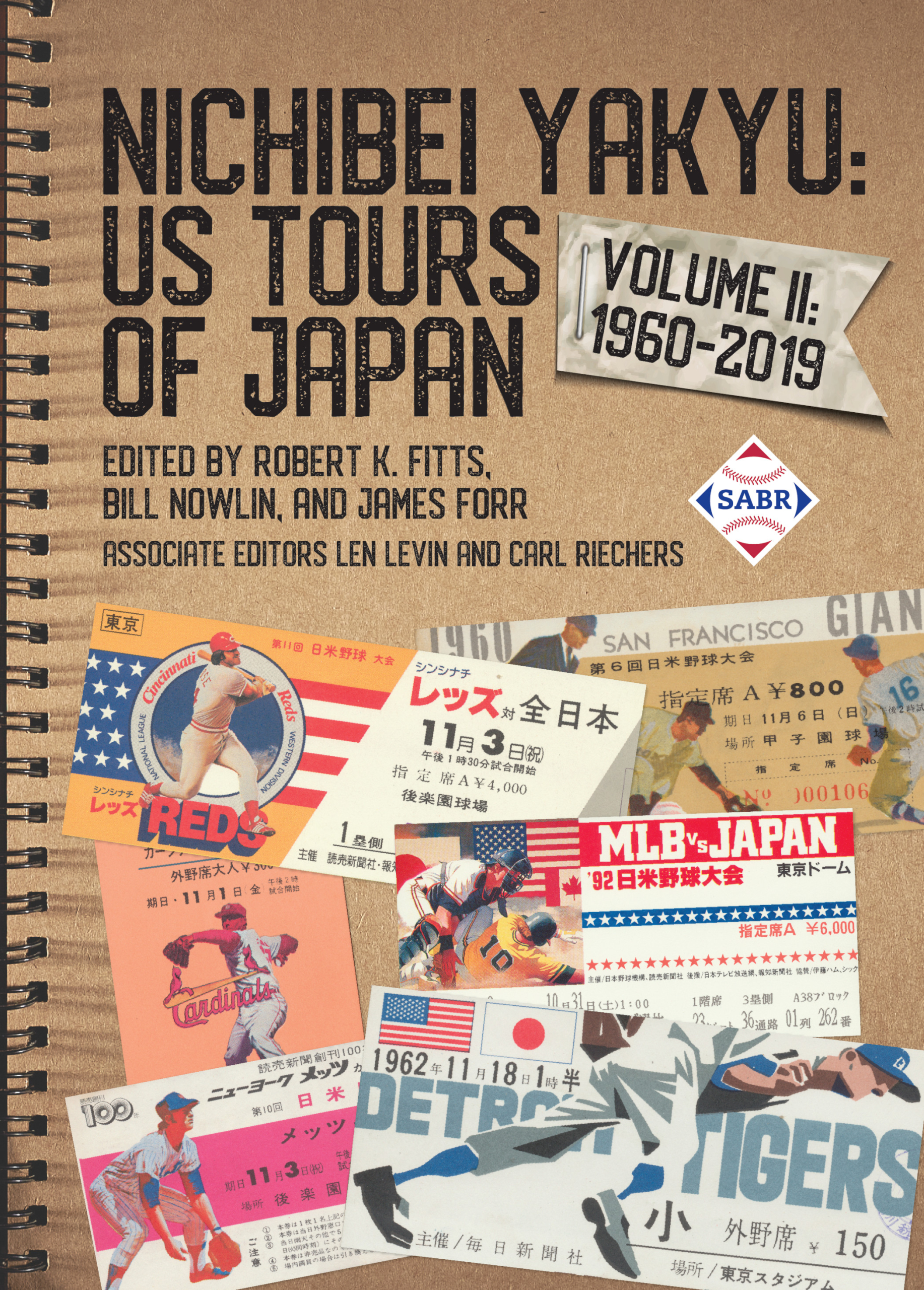 The year 2000 was not just the beginning of a new century for humanity but also marked a new era in Major League Baseball’s relationship with Japan as the New York Mets and Chicago Cubs opened the season in Tokyo. US major-league squads had been touring Japan since 1908 but the 2000 Opening Day Series showcased the first regular-season games played in Japan. It was a rousing success for major-league baseball and Japanese fans. Tickets for both games sold out less than five hours after they went on sale in January. A total of 110,000 fans attended the two games. The games were covered by 125 foreign journalists representing 51 international news organizations and by 250 Japanese media representatives. It was regarded as one of the most important international baseball events ever staged.1
The year 2000 was not just the beginning of a new century for humanity but also marked a new era in Major League Baseball’s relationship with Japan as the New York Mets and Chicago Cubs opened the season in Tokyo. US major-league squads had been touring Japan since 1908 but the 2000 Opening Day Series showcased the first regular-season games played in Japan. It was a rousing success for major-league baseball and Japanese fans. Tickets for both games sold out less than five hours after they went on sale in January. A total of 110,000 fans attended the two games. The games were covered by 125 foreign journalists representing 51 international news organizations and by 250 Japanese media representatives. It was regarded as one of the most important international baseball events ever staged.1
For the New York Mets and manager Bobby Valentine, traveling to foreign countries to play regular-season games was not a new experience. In 1996 the Mets played three games against the San Diego Padres on August 16-18 at the Estadio Beisbol de Monterrey in Monterrey, Mexico. New York lost two out of three games in the series. In 2000 they became the first major-league team to play games in two different countries outside the United States and Canada.2 The Chicago Cubs were making their first international foray after being named a replacement for their Midwest rivals, the St. Louis Cardinals, who were originally supposed to play the Mets in the opener. The Cardinals declined after Mark McGwire expressed his disapproval of playing regular-season games overseas. The Cubs agreed to the trip in mid-August, and details were worked out over the next two months. Though the 1999 home-run king McGwire did not play in Japan, the local fans got to see runner-up Sammy Sosa in person.3
Both teams were going in opposite directions heading into the Opening Day Series. Mets players Bobby Jones, Edgardo Alfonzo, John Franco, and Rey Ordonez remained from the 1996 team that had played in Mexico four years earlier. Since that trip, the Mets had gone 71-91 and finished in fourth place in the NL East in 1996 before they rebounded in 1997 and 1998 with identical 88-74 records, finishing third and second in the division respectively. In 1999 the Mets finished second in the NL East with a 97-66 record and defeated the Arizona Diamondbacks three games to one in the National League Division Series before falling to the Atlanta Braves four games to two in the National League Championship Series.
As the Mets were ascending, the Chicago Cubs were on the decline. Since 1996, the Cubs had three losing seasons (although they did make the National League Division Series in 1998 but were swept in three games by the Atlanta Braves). In 1999 the Cubs finished in last place in the NL Central Division with a record of 67-95.4
Major League Baseball’s decision to play two regular-season games in Japan was a culmination of talks with the host country that dated back to the 1970s. In 1979 the San Francisco Giants and San Diego Padres agreed to play a three regular-season games in March 1980 in Yokohama.5 Unfortunately for US and NPB fans alike, these games were canceled for two reasons. Leadership in both lands worried that the cold and rainy weather that typified Japan in March would cause the game to be rained out and the Major League Baseball Players Association balked at the early date to begin the regular season. It took two more decades to secure the first regular-season major-league games in Japan.6
By 2000, things had changed. American baseball games were shown on NHK Satellite and SKY PerfecTV!, increasing Japanese fans’ interest in the American games. Five domed ballparks had been built since 1979, negating the effects of rainy or windy weather.7 These indoor facilities piqued the interest of Commissioner Bud Selig and the Players Association and they negotiated with Japan Pro Baseball Commissioner Hiromori Kawashima to move forward with regular-season games in Japan.8
The 2000 MLB Opening Day Series was historic for Major League Baseball and also for North American professional sports leagues. MLB became the third North American professional league to play regular-season games in Japan. The NHL began the trend in 1976 and played a total of 10 games in 1997-98 and 2000. The NBA also played 10 regular-season games in Japan in 1990, 1992, 1994, 1996, and 1999. The NFL entertained Japanese sports fans with 10 preseason games between 1976 and 1998 but as of 2022 had not played a regular-season game in Japan.9
The Opening Day Series was also a “homecoming” for several members of the Mets and Cubs. Valentine was making his first appearance in Japan since 1995, when he managed the Chiba Lotte Marines. He would return to Japan in 2004 to manage the Marines for six years, highlighted by winning the Japan Series in 2005. Mets pitcher Pat Mahomes, father of NFL star quarterback Patrick Mahomes, played for the Yokohama Bay Stars in 1997 and 1998. Cubs pitcher Brian Williams played for the Fukuoka Daiei Hawks in 1998. Chicago outfielder Damon Buford lived in Japan as a child, while his father Don played with the Taiheiyo Club Lions and Nankai Hawks from 1973 to 1976.10
The main challenge for the Mets and Cubs would be combating jet lag and fatigue from the airplane trips to Tokyo. The time difference between the US East Coast and Japan was 14 hours. Both teams scheduled ample time to shake off effects of jet lag when they returned to the United States after their week in Japan.11
New York Mets pitcher Mike Hampton was concerned about the physical and mental adjustments he would have to make playing in Japan. “Japan’s going to be a tough trip,” Hampton said. “I just hope everybody adapts all right and gets through it. It’s going to be exciting to go over there and play, but it’s going to be tough. It could take its toll. Hopefully, the effects aren’t too severe, and it doesn’t affect us the first week or two weeks.”12 “It’s baseball, whether we play in the U.S. or Japan. The field is the same. We’ll be playing a talented Cubs team. I’m looking forward to the challenge.”13
Before facing off against each other in the Tokyo Dome, the Cubs and Mets each played two exhibition games against NPB’s Seibu Lions and Yomiuri Giants with identical results. Both teams defeated the Lions and lost to the Giants.14
In the Cubs’ exhibition opener against the Giants, Japanese fans were excited to see Sammy Sosa. He was two years removed from hitting 66 home runs in 1998 and primed to show an international audience his hitting power. On March 27, against the Yomiuri Giants, Sosa was hitless in four at-bats. The hometown Giants led by Hideki Matsui and Yoshinobu Takahashi provided the offensive fireworks, each hitting a home run in the game, which was appreciated by the fans. Matsui would become a New York Yankee in 2003 and play in the United States for 10 years until 2012. Giants pitcher Kimiyasu Kudo proved to be equally potent on the mound, as he shut down the Cubs bats, highlighted by a first-inning strikeout of Sosa.15 Sosa said he was impressed by Kudo’s strong and dominant pitching, which led to a 6-0 victory for the Giants. “Good pitching is going to stop good hitters,” Sosa told the Chicago media after the game. “I have to give them credit for that.”16
Despite the presence of Sosa and other Cubs superstars at the game, the Tokyo Dome crowd remained mostly silent for the duration of at the exhibition game but did get excited with the sighting of US Baseball Hall of Famers Hank Aaron and Ernie Banks, who attended the game. Giants players Daisuke Motoki and Takayuki Shimizu exited their dugout when they saw the duo and asked Aaron and Banks to autograph a bat. After receiving this prized collectible, Motoki and Shimizu showed off the bat to an elated Japanese sports media contingent.17
After being shut out by the Giants, the Cubs were shut out in the first two innings of their second exhibition game in Tokorozawa against the Seibu Lions. Things changed for the Cubs in the top of the third inning when Jeff Huson scored on an error by second baseman Hiromasa Tamano.18 Seibu regained control of the game and took a 5-3 lead entering the ninth inning when a small controversy occurred. After Mark Grace homered to make it a one-run game, the next batter, Henry Rodriguez, had a 3-and-2 count when Lions manager Osamu Higashio decided to use another pitcher to close out Rodriguez’s at-bat. He wanted to call on Yoshihiro Doi, who had just started to throw in the bullpen. In a bit of gamesmanship, Higashio tried to convince the umpire that his pitcher had sustained an injury to give Doi extra time to warm up. Chicago manager Don Baylor became enraged by Higashio’s manipulation and came out of the dugout screaming and protesting. Higashio backed down.19 The Cubs took advantage of Doi not being ready; Rodriguez doubled, and Damon Buford followed with a two-run home run to earn the victory. Buford said the win was very important for the Cubs, even though the game was just an exhibition. “It is great feeling to save face for the Cubs,” he said. “We have some confidence coming into the game [against the Mets].”20
In the Mets exhibition against the Seibu Lions, Glendon Rusch, the Mets’ fifth starter, pitched five shutout innings of one-hit ball en route to an 8-1 victory. Future Hall of Famer Mike Piazza had two run-scoring singles in the win. The Lions featured former major-league players Reggie Jefferson and Tony Fernandez. The Mets outhit their Japanese counterparts, 15-5. There was some humor before the game. In the ceremonial first pitch, Asahi TV host and comedian Kyotaka Nambara accidentally hit future Hall of Famer and New York Mets left fielder Rickey Henderson. After being hit by the pitch, Henderson playfully flopped on his back. Nambora then low-bridged Henderson and they wrestled near home plate before hugging, to the fans’ delight. Inspired by the humorous beginning of the game, Henderson had three hits and one RBI in the Mets’ victory.21
Both teams had a more difficult time with the Yomiuri Giants. The future 2000 NPB champions beat the Mets 9-5 and the Cubs 6-0. The Mets’ four pitchers in this game were from the team’s farm team in Norfolk, Virginia. They were no match for the seasoned Giants batters, who tallied 12 hits for eight runs. The game was humbling for players from both teams. “Everybody’s kind of anxious to go,” Mike Piazza said. “Every year brings a curiosity.”
“You want to find the intangibles, find the ‘wa,’” Piazza added with a smile, referring to the Japanese word for spirit.22 Valentine walked to home plate after the Mets’ 9-5 loss to Giants and bowed deeply to their dugout to show respect for his opponent. He said the games between the Mets, Cubs, and Giants would produce “a true world champion, not just an American champion.”23
The Cubs and the Mets met in the historic opener on March 29. The game was not only the first such opener outside the United States, it was also the earliest Opening Day and the first time since 1869 that the Cincinnati Reds did not play in the traditional first game of the season.24 The 14-hour time difference between Tokyo and New York and the 15-hour time difference between Tokyo and Chicago also made the game time for Americans the earliest start time in major-league history 4:08 A.M. (Central Time) and 5:08 (Eastern Time). The early start times concerned US fans. Commissioner Selig said he was surprised by the early times but was not involved in the decision on starting times for the two games. “It was done for the Japanese people,” Selig said.25
The games were covered by Fox Sports in the United States and on Nippon Hoso (1242 khz on the radio in Tokyo) in Japan. Marty Kuehnert and former New York Yankee and Seibu Lion Orestes Destrade did the English language play-by-play for both games for Nippon Hoso.26 Kuehnert became a senior adviser to the Japanese professional baseball team Tohoku Rakuten Golden Eagles. He was also the team’s first general manager and Nippon Professional Baseball’s first foreign general manager.27 Kuehnert was impressed with what he witnessed. “My thoughts about the two games were that it was thrilling to see the ‘real thing’ after many years of seeing many MLB exhibition games,” he said. “Everyone associated with the games, fans, media, and staff, were most impressed that they got to see major leaguers giving a hundred percent for the first time in Japan. These first official MLB games outside of North America in 2000 were so successful they gave huge impetus to have many more, and thus we have had nine subsequent series, four more of them in Japan.”28
The two games had a distinct NPB flavor. Both teams had advertisements on their caps and jerseys for the sponsoring Yomiuri Shimbun, a division of the company that owns the Yomiuri Giants. The Tokyo Dome was full of excited Japanese baseball fans – many wearing surgical masks to protect themselves from a very high pollen season. Crown Prince Naruhito was in attendance and took in the game from his royal box. The Japanese baseball fans enjoyed their sushi with chopsticks from their bento boxes. The fans did refrain from their traditional singing and chanting and using horns and drums as they do during the NPB regular season.29 Before the first contest, five women dressed in traditional kimonos gave flowers to the four US major-league umpires and both teams.30
Former Houston Astros starting pitcher Mike Hampton was making his Mets debut in the opener and struggled mightily. He walked nine batters, threw a wild pitch, and gave up four hits in five innings. Still, he surrendered just two runs. Jon Lieber, Chicago’s starting pitcher, put the clamps on the Mets for seven innings, as the Cubs entered the bottom of the eighth inning with a 5-1 lead. But then relief pitcher Brian Williams walked Edgardo Alfonzo and gave up a home run to Mike Piazza to tighten Chicago’s lead to 5-3 before retiring the next three batters.
The game had two significant controversies. The dirt on the playing field was extremely soft and it put the players in danger. It almost led to leg injuries to Mets third baseman Robin Ventura and outfielder Darryl Hamilton, who both got stuck in the sand during their at-bats. The Tokyo Dome grounds crew tried to fix the soft dirt but because they lacked a sufficient amount of clay, they failed to get the field in proper playing condition.31
The second controversy happened in the bottom of the ninth inning. Cubs skipper Don Baylor inserted relief pitcher Rick Aguilera and had Jeff Huson take Jose Nieves’ place at shortstop. Valentine noticed that Baylor had mistakenly left Huson off his lineup card, making him ineligible for the game. He complained to home-plate umpire Randy Marsh that Huson was ineligible. Baylor told Valentine and Marsh that he accidentally wrote backup catcher Jeff Reed’s name twice on the lineup card instead of correctly writing Huson. Marsh let the game continue with Huson in it. Valentine was upset with the decision and protested it with two outs and Matt Franco on the plate.32 Aguilera closed out the game and Valentine immediately rescinded his protest.33
The second game matched the drama of the first one. It was an 11-inning battle and a pitchers’ duel. Starters Rick Reed for the Mets and Kyle Farnsworth for the Cubs shut down their opponents’ offenses for the first four innings as both teams were scoreless. Each team got a run in the fifth. In the seventh inning, the Mets’ Rickey Henderson stole second base, becoming the first player since Ted Williams to steal a base in four different decades.
In the top of the 11th inning, pitcher Danny Young, making his major-league debut, entered the game for the Cubs. He got the first two batters out, then gave up a single to Todd Zeile, and walked Rey Ordoñez and Melvin Mora, loading the bases. Benny Agbayani, pinch-hitting for Mets pitcher Dennis Cook, hit a grand slam to put the Mets up 5-1. The Cubs went down quickly in the bottom of the inning, and both teams returned to the United States with a 1-1 record in the regular season.
The Cubs finished the season sixth in the National League Central Division with a 65-97 record, while the Mets finished second in the National League East with a 94-68 record, earning a wild-card slot in the National League postseason. They defeated the San Francisco Giants, three games to one, in the National League Division Series and the St. Louis Cardinals, four games to one, in the National League Championship Series, before losing to their crosstown rival New York Yankees in the World Series.34
The success of the 2000 Opening Day Series in Japan paved the way for major-league baseball to play regular-season games in Japan in 2004, 2008, 2012, and 2019.35 “The five official MLB series played in Japan got MLB personnel, including scouts, used to coming over to Japan to search for talent,” noted Marty Kuehnert. “Right after this 2000 series the Seattle Mariners signed flame-throwing reliever Kazuhiro Sasaki, and a year later they also signed the magnificent Ichiro Suzuki. The floodgates opened, and they will not be closed.”36 Since the 2000 series, more than 60 NPB players, including Ichiro, Hideki Matsui, and Shohei Ohtani, have played in the North American major leagues.
SCOTT MELESKY has been a sports journalist for 20 years. He graduated from Syracuse University with a bachelor’s degree in history in 1995. Melesky earned his master’s degree in education from Pacific Oaks College in May 2021. He has worked for and contributed stories as a sports editor and writer for the Los Angeles Daily News, Glendale News Press, Patriot Ledger, Syracuse Herald Journal, New Haven Register, Waterbury Republican, Naugatuck News, Southington Observer, Westchester Daily Local News, Van Nuys News, L.A. Parent, Highlights, Japan Ball, Team Fenom, and SPM.com. Melesky has also worked in the sports information departments at Marquette University, Ohio University, Quinnipiac University, and the Florida Institute of Technology. Melesky is a member of the Society for American Baseball Research, the Institute for Baseball Studies, the Association for Professional Basketball Research, and the Professional Football Researchers Association. He has contributed writings to the Society for American Baseball Research’s books: Beisbol: Latino Broadcasters on the Air, The Colorado Silver Bullets, and to James Cryns’ On Story Parkway: Remembering County Stadium.
(Click images to enlarge)
Notes
1 Stephen Ellsesser, “MLB Is No Stranger to Japan,” MLB.com, March 19, 2008. http://mlb.mlb.com/content/printer_friendly/mlb/y2008/m03/d18/c2441756.jsp.
2 David Adler, “Complete History of MLB Games Played Abroad,” MLB.com, March 6, 2020, https://www.mlb.com/news/baseball-games-played-outside-the-us-c272441130.
3 Dan Moscoe, “Sammy vs. Yoshii: Big-league Baseball Coming to Japan,” Japan Times, October 8, 1999: 20.
4 “1999 National League Season Summary,” Baseball Reference.com, November 1, 1999. https://www.baseball-reference.com/leagues/NL/1999.shtml.
5 Associated Press, “Giants-Padres to Open ’80 in Japan,” Fort Walton Beach (Florida) Playground News, March 27, 1979: 9.
6 Wayne Graczyk, “Cubs, Mets Set to Make History in Japan,” Japan Times, March 24, 2000: 21.
7 Graczyk.
8 Graczyk.
9 Graczyk.
10 Graczyk.
11 George Vecsey, “Mets-Cubs Baseball Game in Japan Will Be an Unusual Eye Opener,” New York Times, March 28, 2000: D3.
12 Tyler Kepner, “The Mets Begin Their Journey as Time Travelers,” New York Times, March 24, 2000: D4.
13 Vecsey, “Mets-Cubs Baseball Game.”
14 Ellsesser.
15 Daniel Rivkin, “Cubs Fever Less Than Fervent,” Chicagosports.com, March 27, 2000.
16 Ginny Parker (Associated Press), “Cubs Open Trip with Loss,” Chicagosports.com, March 27, 2000.
17 Parker.
18 Daniel Rivkin, “While You Were Sleeping,” Chicagosports.com, March 28, 2000.
19 Teddy Greenstein, “Baylor Already Competing,” Chicago Tribune, March 29, 2000: 4: 1, 5.
20 Teddy Greenstein, “9th-inning Rally Places Club in Proper Place,” Chicago Tribune, March 29, 2000: 4: 5.
21 Vecsey, “Mets Cubs Baseball Game.”
22 George Vecsey, “A World Champion Could Be on the Horizon,” New York Times, March 29, 2000: D2.
23 Vecsey, “A World Champion Could Be on the Horizon.”
24 Timeline, CincinnatiReds.com, https://www.mlb.com/reds/history/timeline.
25 Vecsey, “Mets-Cubs Baseball Game.”
26 Graczyk.
27 Marty Kuehnert, ISMAC, http://www.ismac.co.jp/english/.
28 Marty Kuehnert, email interview, August 30, 2021.
29 Associated Press, “Cubs Beat Mets, 5-3,” Ironton Tribune, March 29, 2000.
30 Associated Press, “Cubs Beat Mets, 5-3.”
31 Teddy Greenstein, “Right Out of the Box a Problem – No Clay,” Chicago Tribune, March 30, 2000: 4: 3.
32 Rafael Hermoso, “Hampton Debut No Walk in the Park,” New York Daily News, March 30, 2000: 84.
33 Teddy Greenstein, “It’s Not Valentine’s Day – Protest Proves Meaningless,” Chicago Tribune, March 30, 2000: 4: 3.
34 2000 National League Season Summary, Baseball-Reference.com.
35 Adler.
36 Kuehnert email interview.
37 These tables include all participants in the series. “Scoreboard,” Arlington Heights (Illinois) Daily Herald, March 28, 2000: 2: 6; “Scoreboard,” Arlington Heights (Illinois) Daily Herald, March 29, 2000: 2: 6; “Baseball,” New York Daily News, March 28, 2000: 71; “Baseball,” New York Daily News, March 29, 2000: 72.


